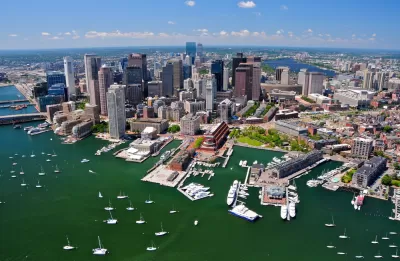For the first 300-or-so years of its history, Boston built some of the most handsome, historic neighborhoods in the country. Lately, says critic Rachel Slade, it has given in to mediocrity. Mayor Marty Walsh is trying to undo the damage.

Rachel Slate of Boston Magazine sticks it to her city's architectural community with a savage appraisal of what she describes as dull, derivative architecture, especially among the city's new towers. She notes the irony that the city has some of the best design schools in the world—including Harvard Graduate School of Design and MIT's School of Architecture—and yet does not have the political will to compel developers to take advantage of local talent.
"Our city lacks a consistent language to express its desires. We fumble for the right words because design has so seldom been part of the discussion about development. We don’t have a vocabulary to describe it. And the problems with turning this ugly city into a 21st-century design mecca run far deeper than that: It’ll take more than just the mayor’s vague notion that design matters. The rest of the city needs to get onboard, too."
FULL STORY: Why Is Boston So Ugly?

Americans May Be Stuck — But Why?
Americans are moving a lot less than they once did, and that is a problem. While Yoni Applebaum, in his highly-publicized article Stuck, gets the reasons badly wrong, it's still important to ask: why are we moving so much less than before?

Using Old Oil and Gas Wells for Green Energy Storage
Penn State researchers have found that repurposing abandoned oil and gas wells for geothermal-assisted compressed-air energy storage can boost efficiency, reduce environmental risks, and support clean energy and job transitions.

Placekeeping: Setting a New Precedent for City Planners
How a preservation-based approach to redevelopment and urban design can prevent displacement and honor legacy communities.

San Francisco’s Muni Ridership Grew in 2024
The system saw its highest ridership since before the Covid-19 pandemic, but faces a severe budget shortage in the coming year.

Colorado Lawmakers Move to Protect BRT Funding
In the face of potential federal funding cuts, CDOT leaders reasserted their commitment to planned bus rapid transit projects.

Safe Streets Funding in Jeopardy
The Trump administration is specifically targeting bike infrastructure and other road safety projects in its funding cuts.
Urban Design for Planners 1: Software Tools
This six-course series explores essential urban design concepts using open source software and equips planners with the tools they need to participate fully in the urban design process.
Planning for Universal Design
Learn the tools for implementing Universal Design in planning regulations.
Heyer Gruel & Associates PA
City of Moreno Valley
Institute for Housing and Urban Development Studies (IHS)
City of Grandview
Harvard GSD Executive Education
Salt Lake City
NYU Wagner Graduate School of Public Service
City of Cambridge, Maryland


























